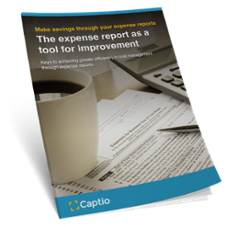The efficiency of management processes is and must be one of the company’s greatest obsessions. The business travel expense management process often presents significant margins for improvement, eliminating manual tasks, paper-based workflows, better communication between the parties involved and reducing internal bureaucracy.
The traditional business expense management process is highly inefficient. A key reason for this is the large degree to which the process is paper-based. Envelopes stuffed with receipts, printed expense reports, etc. On the one side, this involves and underlying problem in relation to errors caused by the medium itself: papers that get lost, receipts that are illegible, etc. On the other side, paperwork is always associated with manual input involved in the tasks and increased bureaucracy.
There is a range of points to address in order to bring about an improvement in expense management efficiency. Firstly, the automation of tasks, enabling the process to be conducted with the minimum possible degree of human intervention, reducing the resources required to the absolute necessities at all stages of the process. At the reporting stage, it speeds up the time that employees have to spend drafting expense reports. During the revision process, it makes the job as easy as possible for the supervisor to detect problematic cases and approve or reject the reports.
Another reduction, are the errors that cause halts in the process resulting in unnecessary delay Receipts that are entered incorrectly on the expense report, lost original copies, etc.
The synchronization and improvement of the different parties involved in the reporting and validation process is also a key factor in improving the efficiency of the expense management process. This ensures that the process moves forward through its various phases fluidly and without hold-ups, considerably reducing the time spent.
Captio enables these performance parameters to be improved. The first step towards doing so is to transform the paper-based process so that it can be shifted to the digital world. Using smartphones, expense receipts can be digitized and stored on the cloud. From that point onwards, the rest of the process takes place without any need for paper.
HAVING THE INFORMATION AVAILABLE IN A DIGITAL FORMAT ENABLES THE EXPENSE MANAGEMENT PROCESS TO BE STRUCTURED IN A RADICALLY DIFFERENT WAY.
Having the information available in a digital format enables the process to be structured in an automated way. The information on the receipt is read automatically by the Captio system. This means that the receipts are scanned and data, such as the amount, the supplier and the date, are automatically recognized and stored. In the end, this enables the employees’ expense reports to be generated automatically without them having to waste even a minute of their time on the task.
However, automation goes even further. As we now have access to the information extracted from the receipts that all of the employees have reported, a system can be implemented that automatically verifies their validity. All of which takes place without any supervisor having to review the expense reports.
ALL THE PARTIES INVOLVED WORK WITHIN THE SAME ENVIRONMENT AND EACH PHASE IS SYNCHROMNIZED.
Moreover, the whole process takes place within the same environment that can be accessed at anytime from anywhere by anybody involved in the process. With all of the pieces in alignment, the performance of the expense management process is enhanced and the costs involved are radically decreased.




